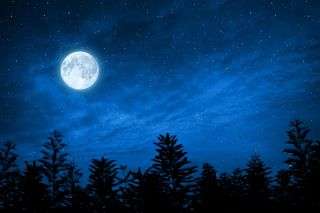
This week, for the first time in three years, the September full moon is in a unique situation: it’s happening so early in the month — a timing that gives it an entirely different name, the corn moon, instead of the harvest moon — that it sets the stage for October to have two full moons, meaning a rare blue moon will shine this Halloween, on Oct. 31.
This full moon, named for the East Coast corn harvest, will reach peak fullness at 1:22 a.m. EDT (5:22 UTC) on Wednesday, Sept. 2, according to NASA.
Usually, September’s full moon is known as the harvest moon, as it’s typically the full moon closest to the first day of fall, known as the fall equinox. But this year, the autumnal equinox falls on Sept. 22, making the Oct. 1 full moon the harvest moon, according to Lehigh Valley Live, a news outlet in Easton, Pennsylvania.
As with every full moon, September’s moon will appear full for three consecutive days, starting tonight (Aug. 31) through Thursday morning (Sept. 3).
Full moons happen when the sun, Earth and moon form a line, allowing the side of the moon facing Earth to be fully illuminated by the sun, according to Space.com, a Live Science sister site.
On the evening before the true full moon, you can catch September’s full moon rising at 8:12 p.m. EDT this Tuesday (Sept.1). The celestial show is easily seen with the naked eye (preferably away from glowing artificial lights), but binoculars can help you gaze upon the moon’s terrain so that “smooth-looking patterns of gray and white resolve into craters and large mountain ridges,” according to NASA. Meanwhile, a telescope can help you spot the moon’s mountains, valleys and “the cracks in the moon’s surface called rilles, [which] formed when the lava that once filled a basin cooled and contracted,” according to NASA.
Skywatchers can also catch bright views of Jupiter and Saturn. Jupiter was at its closest and brightest for 2020 on July 14, while Saturn was at its closest and brightest on July 20, according to NASA. This is known as “opposition,” as these planets were positioned on the opposite side of Earth than the sun was shining on. Even though these planets are past their closest-and-brightest approaches to Earth, they’re still brighter than usual. Look for them in the western sky. If you have a telescope, try to find Jupiter’s four bright moons: Ganymede, Callisto, Europa and Io, NASA recommended. A telescope can also help you spot Saturn’s illuminated rings and some of Saturn’s moons, including its largest moon, Titan.
RELATED CONTENT
—Photos: 2017 Great American Solar Eclipse
—Photos: Super blood wolf moon eclipse stuns viewers
—In photos: Ancient rock art depicts total solar eclipse in Chaco Canyon
After the next full moon on Oct. 1, the hunter full moon will light up the night sky for socially-distanced trick-or-treaters this Halloween.
Other names for September’s corn moon (which was bequeathed by the now defunct Maine Farmer’s Almanac in the 1930s) include the fruit, barley and hungry ghost moon, which references the Chinese Hungry Ghost Festival that happens on the 15th day of the seventh month of the Chinese lunar calendar, according to NASA. On this day, ghosts and spirits, including those of ancestors, are believed to visit the living.
Originally published on Live Science.
Sourse: www.livescience.com





